
Evam 2024
- Rajiv Rajamani
e-mail: rajivrajamani@yahoo.com
Photos: Suresh Muraleedharan
March 6, 2024
Keerthana Ravi presented three unique ensemble performances of dance for
the seventh edition of the Evam festival in Mumbai on Feb 4, 2024.
Thyagaraja Ramayanam
(Dr Ananda Shankar Jayant and Neha Sathanapalli)
For millions of Indians, the saga of Rama and Sita is neither myth nor
magic; it is perhaps just a means of channelling our energies. Dr Ananda
Shankar Jayant's Bharatanatyam gave expression to that energy through
the musical medium of Saint Thyagaraja's compositions.
The voicing of Thyagaraja's lyrics in lilting Telegu was complemented by
the grandeur of classical Sanskrit of Valmiki. Each kriti provided a
very different temperature, reflecting the different moods of
Thyagaraja's relationship to Rama, which in turn echoed some sentiment
or incident in the Ramayana.
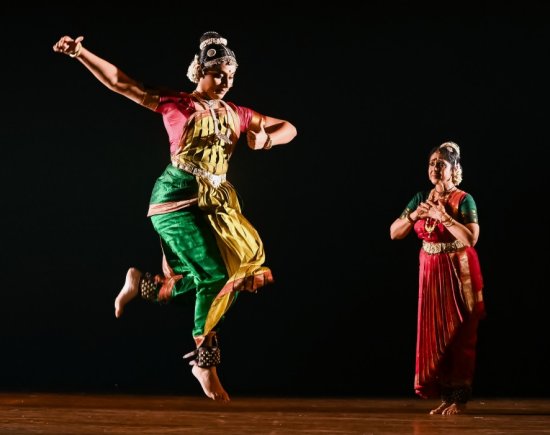
The duo of dancers performed in tandem - through natya or mime and
nritta or pure dance. Ananda Shankar Jayant's choreography of the nritta
interludes was dazzling and very lively. The steps and movements
actually pointed us clearly to what was happening in the story: the
sprightly maiden stringing garlands for a happy occasion at the opening,
the vigour of bearing the mighty bow of Shiva in heroic alidha and
pratyalidha postures, the sliding adavus as Bharata bent down to hoist
the precious sandals of Rama onto his head to carry back to Ayodhya, the
rhythms of the final duel in Lanka climaxing in a teermanam that ended
precisely on the fell blow that slew Ravana! Every move had a meaning
and purpose that was evident to the seasoned rasika and was thrilling
and dramatic to the new audience at the same time.
The emotional highpoints were intensely moving. Shringara was depicted
with a sense of intimacy, for despite all the political commentary in
gender studies on the Ramayana it is essentially one of the greatest
love stories ever told. The lajja or bashfulness of Sita when she
experiences Rama's touch for the first time sent a shiver down many
spines. The sense of betrayal felt by Vali was convincingly portrayed in
"Marukelara" in raga Jayantashri. "Don't hide from me, Oh Rama?" - the
subtle turning away of Rama when he plucks out the arrow from Vali's
breast was telling. "Enthaninne" in Ahiri ragam extracted all the
vatsalya in mother Shabari's heart, when she offered wild fruit to the
prince. Ravana's rage at failure in Sita's swayamvara was crystallised
into one lingering teardrop in the corner of the dancer's eye. The
dancers conjured up the grand imagery of building the sea-bridge to
Lanka by the vanara army. The majestic finale of the coronation was
truly evocative - Shri Rama in rajalilasana (royal ease) shown by an
ekapada sthana pose with one bended knee crossed over the other,
surrounded by his family and retinue.
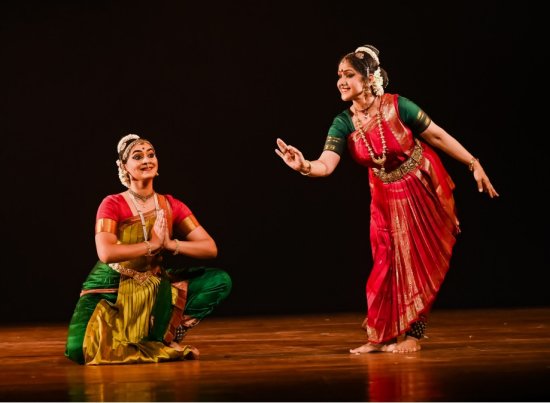
Neha Sathanapalli shone as a bright young star with near perfect form
and abhinaya that was not restrained, but rather deliberate and
palpable, which was in keeping with the operatic tenor of this
presentation. Overall it was a holistic experience of
Bharatanatyam both as a medium of storytelling and also pure dance, with
Thyagaraja's music "in front" of everything that was happening on
stage.
Four Seasons
(Vaibhav Arekar & Sankhya Dance)
Vaibhav Arekar challenged the audience to look within and observe inner
feelings, whilst perhaps using the outer seasons as representations to
experience them.
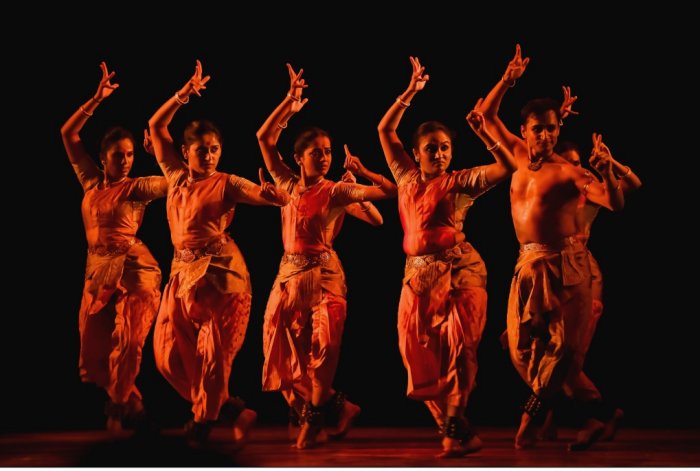
In Grishma (Summer), abstractions were crafted in pure nritta. The
vigour and synchronicity of the choreography permeated down to the
smallest muscle and faintest expression of the dancers. Breathing in and
out, holding back or wanting to express. Dancer Swarada Bhave was lost
in the savage force of the rhythm that was a motivating impetus driving
her on and also holding her back.
Varsha (Rains) was prefaced by a beautiful sonnet with fecund imagery of
lovers united and blooming life. But seeing and experiencing the rain,
is also tinged with the pain of remembrance of a relationship that seems
to be over. Rajashree Pathak sang "Dadur mora" in a languorous
rendition of Desh raag.
Shishir (Winter) depicted the disconnect and barrenness of our modern
lives. Digitally connected but socially disconnected! The
instrumentation was telling - a discordant low pitched bamboo flute to
cue discontent. The dancers' mastery of weight transfer and control of
momentum was amazing. It was synchronised with the movement but also
infused with staccato stops and turns that deliberately went against the
flow.
In Vasant (Spring), Swarada Bhave and Poorva Saraswat unfolded the
potential of a traditional Javali - "Yera ra ra" with a tongue in cheek
depiction of an aging courtesan egging on her young daughter to solicit
clients!
Rasa flowed from the clicking of fingers and new grammar seemed to
emerge from the clapping of hands. Unfamiliar dissonant motions leaned
into comforting jatis. The asynchronous was thrilling and the accustomed
teermanam was never cloying! At which point did "free" dance give way
to adavus or vice-versa? This liminality is the real triumph of Vaibhav
Arekar's choreography.
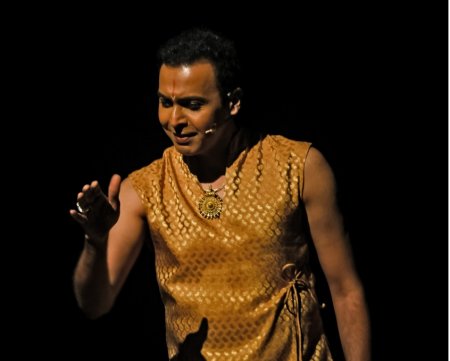
Vaibhav Arekar
Perfect aharya or costume in muted skin tones rendered the torsos
genderless. A recumbent figure splaying and closing its bent knees like a
sighing accordion, pleating and unpleating - was it a saree or a
dhoti? Perhaps only the glistening sweat on Manmatha's sinewy
torso revealed his gender. Gautam Marathe as the God of Love danced with
flawless form, whirling on his feet like an intoxicated flower, petals
unfurled, spiralling down to spin on his knees as if on an ice skating
rink!
The music by Aalap Desai created a match of sophisticated textured
soundscapes for the range of emotions. Sushant Jadhav's lighting was
pure genius. It was figurative and yet intangible too - the paradox of
dancers lost in the glare of light but revealed in darkness!
Naachiyar Next
(Dr Anita Ratnam & Arangham Dance Theatre)
Dr Anita Ratnam's choreography and savvy theatrical sense infused
"Naachiyar Next" with mesmeric tableaux and inexplicable emotions.
Embodied as sutradhar, mother and dancer, all rolled into one, she
straddled myth and metaphor with a clear exposition.
The opening paces depicted the discovery of Godhai as a foundling under a
tulasi bush by a temple priest of Srivilliputtur, Vishnuchittar. The
dancers captured a botanical image of a quivering basil plant which
melded into lovely female forms. The dance went on to portray the young
girl's growing attraction to Lord Ranga - awakening her slumbering
friends to bathe in the river with verses from the Thiruppavai and
wearing the tulasi garland meant for the deity, much to the horror of
her father.
When Godhai addressed the White Conch or Shankh in "Karpuram naarumo" it
was playful at the start but it soon became evident that a very adult
note had been infused into the otherwise cozy scene. Anita held the
conch and Godhai approached it in a trance with all the longings of a
maiden on the cusp of womanhood. By an enigmatic confluence of bodily
and emotional suggestion, the Shankh almost transformed into a fetish.
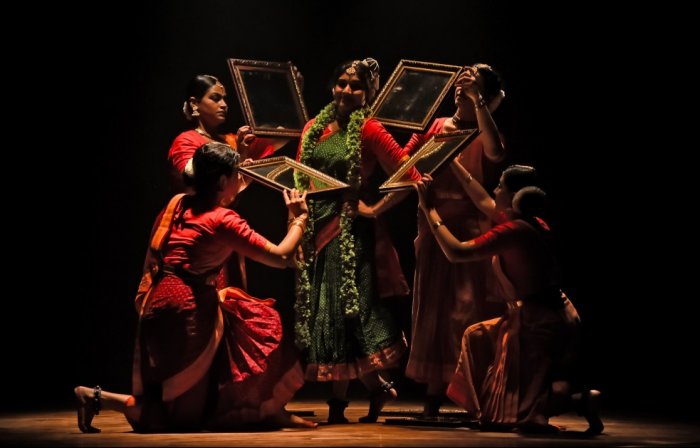
Godhai lost her self-consciousness. She began singing her own song. The
dancers too stepped into the song. They moved as one body of feeling.
They held up gold rimmed mirrors that reflected Godhai's emotions as
brassy beams that seared the darkness - poignant, arresting tableaux
employing lights, props and stagecraft masterfully.
The astonishing line and placement of the kolattam sequence and the
palanquin scene when four dancers processed the Lord was superb. But
what was most memorable, more than the precision, was the lushness of
the dancers, who performed with a complete lack of artifice or pretence.
Nandini Ganesh Subbulakshmi as Godhai had an absorbing and vulnerable
quality.
An all-woman orchestra provided expressive accompaniment. The music was
interpolated with a soaring, pining cry of unbridled longing,
intimations of self-annihilation through love - "Ranga Ranga!" The
impetuosity of writhing bodies bearing Godhai receded headlong into the
darkness. The brush of peacock feathers against her inflamed body evoked
the ecstasy of St Teresa of Avilla as the Angel pierced her heart with a
golden tipped arrow. Anita Ratnam's vision was as daring and risqué as
Bernini's sculpture!
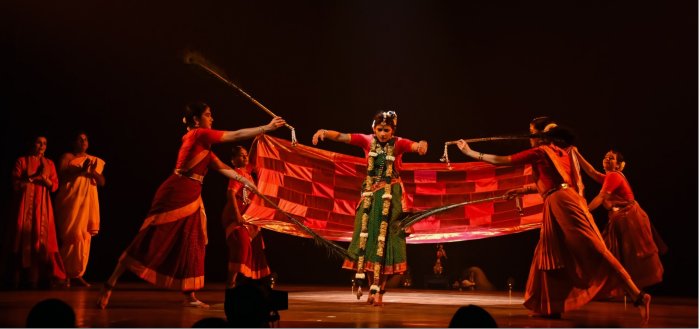
The red bridal canopy over Godhai's head was like a fragile hymen
insinuating the advance from girlhood to womanhood; or was it maidenhead
to Godhead? The gossamer fabric transformed into a curtain covering the
garbhagriha, the womb-like innermost sanctum. A conch blew stridently.
The curtain dropped to reveal Godhai deified as Goddess Andal!
The stentorian voice and pompous bearing of Madhusudanan Kalaichelvan as
an Araiyar brought to the urban stage the rare Araiyar Sevai, a ritual
dance performed by priests at select Vaishnava temples. Shridhar
Vasudevan made an impression as the diligent priest and garland maker of
the Lord, as also a distraught father in quandary. These two strong
"male" characters represented the conservatism and patriarchy which
tried to sublimate Andal's passionate poetry through the filter of
devotionalism, and even performed her "Pran Pratishtha" as a temple
icon! While orthodoxy may have veiled the sensual within the sacral and
sought to desexualise her passion through deification, it has also
helped to preserve Andal's poetry and cultural memory in society.
Andal's hymns and her short life's journey have been included in the
liturgical practices of Vaishnava temples, as explained by Anita Ratnam.
The salient feature to modern exegetes of Andal's life and poetry is
perhaps its eroticism while for the conventional laity it is its
devotionalism. Anita Ratnam, abetted by the nuanced pen of poet Priya
Sarukkai Chabria has played with this exciting dichotomy. Hers is a
richly layered and intensely personal take on Andal as a free spirited
woman.
The dancers invited the audience to join in the singing of the
Thiruppavai verses at the curtain call. My nonagenarian father obliged
happily and continued to sing all the way on the long drive back home!
This is precisely why I love Evam so much. Almost a decade, Keerthana
Ravi has offered up a rich and variegated classical dance fare, wholly
crowd-funded, that touches Mumbaikars in many different ways.
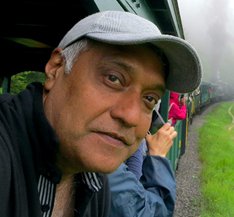
Rajiv Rajamani is a film maker, author and connoisseur of classical
music and dance based in Bombay, Auckland and Chennai (during the
season).
|





